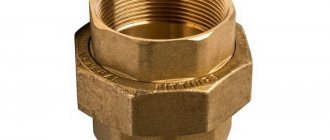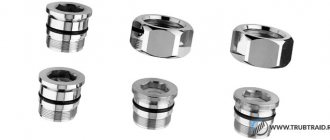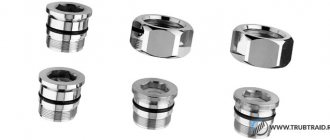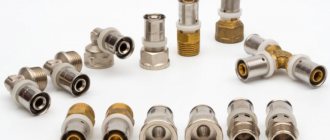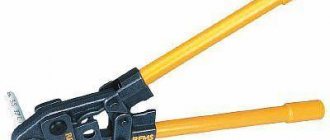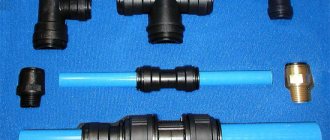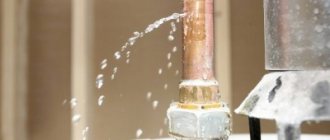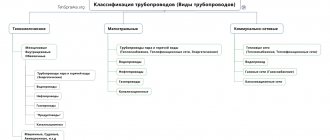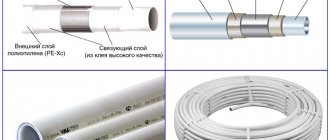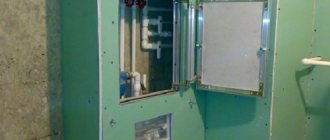Greetings my dear reader! The most valuable resource for all humanity and every person in general is time. It is irreplaceable. This article talks about what threaded fittings for engineering systems are - devices that save our valuable time.
Before the widespread use of threaded connections, installation of plumbing and heating took a lot of time, required a heavy welding machine, considerable preparatory and cleaning work, and then restoration of the damaged interior. When using threaded connectors, the installation of engineering systems is accelerated significantly, does not require high qualifications from the contractor and practically does not destroy the existing decoration of the premises.
Design and purpose of threaded fittings
Almost all connectors consist of a body on which on one, two or more sides there is a pipe with an external thread or a union nut with an internal thread. The coupling design with internal thread is now not very common - it is not so convenient for installation.
The design of the second side can be different - in the form of a crimp and press connection, with an extension for soldering on copper elements.
For polypropylene pipes, combined couplings with a plastic pipe for soldering are used, for polyvinyl chloride pipes - for gluing, and for polyethylene pipes - in the form of a collet clamp.
Fittings are used for connecting, branching, turning pipelines, for connecting shut-off and control valves, heating devices to pipes, and for changing to a different diameter. Fittings are used on all types of pipelines.
Most often, pipes are connected by soldering, compression or press fittings, and threaded fittings are located only at the system entry into a house or apartment and at the connection points of radiators, taps, and mixers. Assembly of the entire system on threaded connections is used extremely rarely and only for steel pipes.
Threaded fittings for metal pipes - catalog
Metal threaded fittings are supplied to the market by a wide range of Russian enterprises and firms, Chinese and European companies. The vast majority of products are made of brass and practically do not differ in appearance from different manufacturers. When choosing fitting connectors, the consumer may be faced with different types of metals used to make them; he will also have to buy the product, comparing prices and quality of products from different manufacturers.
Steel products
Steel fittings are used when laying pipelines made of similar material. Since steel has long lost its attractiveness for domestic use, they are mainly used for connecting new radiator heat exchangers to old pipelines and carrying out repair work. Steel products are distinguished by high temperature resistance and strength; to protect against corrosion, many fittings are coated with zinc.
Steel couplings with cylindrical threads without and with zinc coating are manufactured in accordance with GOST 8966-75. They are designed for system pressure up to 16 bar and temperature parameters of the working environment not higher than 175 °C.
Squeegees and barrels are produced from sections of water and gas pipes in accordance with GOST 8969-75.
Rice. 7 GOST 8969-75 and 8966-75 for standard sizes of steel bends and couplings
Related article:
What are the types of fittings for metal-plastic pipes, installation features. The article describes options for connecting metal-plastic pipes, types of fittings, an overview of leading manufacturers and installation instructions.
The catalog of threaded fittings for steel pipes from one of their manufacturers and sellers (Prokonsim company) consists of the following items:
- Drives with double-sided threads (one side has a longer thread length) made of ordinary black galvanized steel. Squeegees are designed to connect two fixed pipelines.
- Cylindrical barrels made of black and galvanized steel with double-sided external threaded knurling.
- Barrels with one-sided thread for welding.
- Couplings of excellent standard sizes for external joining of pipelines.
What materials are they made from?
Threaded fittings are made of brass (sometimes bronze), steel, copper, and ductile iron. Sometimes the metal matches the material of the pipes, sometimes not. Brass or combined products are usually installed on plastic pipes, only copper with brass parts are installed on copper pipes. Fittings made of any metal can be installed on steel pipes.
Made of brass
Brass is a multicomponent alloy based on copper and zinc with small additions of tin, nickel, lead, iron, and manganese. The industry produces products of all conceivable shapes, designs and diameters. Almost all hardware stores and even supermarkets sell brass threaded fittings.
This is the optimal connector for household and most industrial engineering systems. Brass is very strong, durable, not prone to corrosion (although it darkens over time), ductile, chemically inert and harmless to humans. Moreover, it is inexpensive, can be disposed of without harming the environment - it is simply melted down into new products.
The disadvantage of brass fittings is that the working pressure is limited to 1.6 MPa, the maximum pressure is 2.5 MPa, therefore, at high pressures of the working environment, brass threaded connectors are unsuitable.
Cast iron
Nowadays this is already a rarity, but sometimes cast iron corners and tees with threads are still found. Their main disadvantages are fragility and tendency to corrosion.
Steel
Steel products are quite rare. Modern ones are plated with nickel (sometimes with chromium). Mainly used for industrial engineering networks made of metal pipes with high pressure.
Strong, reliable, durability – about 20 years or more. Prone to corrosion.
Copper
Copper is a very soft metal, and cutting threads on copper tubing is difficult - it can easily become deformed. When people talk about threaded copper connectors, they usually mean a combined fitting - on one side a copper tube with a solder extension, on the other side a brass union nut. The quality of such products is approximately equal to brass ones.
Threaded pipe fittings - materials of manufacture
It is generally accepted that threads are used to make connections in metal pipelines with diameters up to 50 mm (2 inches). For these purposes, fittings made of the following metals are used:
Steel. To produce fittings using generally accepted technology, pieces of cylindrical cross-section rod are taken, which are formed by hot stamping. After this, a threaded notch is cut into the workpieces.
Many private manufacturing companies use water and gas pipes in the manufacture of straight elements (strains, barrels, extensions). Their nominal bore, approximately equal to the internal diameter of the pipe passage, for domestic use corresponds to the digital series 10, 15, 20, 25, 32, 40, 50 mm and is fully correlated with inch dimensions.
The material for water and gas pipes is carbon steel of ordinary quality, grades from St0 to St6 with the degree of deoxidation (according to GOST 380-2005): boiling (kp), semi-quiet (ps) and calm (sp). Also for fittings, unalloyed high-quality and special grades of structural steel from St8 to St60 (according to GOST 1050-2013) can be used.
To protect steel parts from corrosion and improve the aesthetics of their appearance, they are often coated with zinc.
Rice. 2 Standard sizes and weight of water and gas pipes according to GOST 3262-75
Cast iron. This type of fittings is obtained after casting and heat treatment of soft, viscous and ductile white cast iron. Products can be produced in black without treatment or with zinc coating, which increases their anti-corrosion properties and gives them a silver color. The main advantage of cast iron is its low cost, better corrosion resistance than steel, and therefore a longer service life.
Stainless steel. Stainless steel with high corrosion resistance is obtained by adding at least 13% chromium to the alloy. The main types of stainless steel for the production of fittings are grades 12Х18Н10т (18% chromium X and 10% nickel H), AISI 304 (analogous to 08Х18Н10), AISI 316 (316L according to GOST – 03Х17Н14М3, 08Х17Н13М2, 316Ti – 10Х17Н13М2Т). Most often they are made from inexpensive stainless steel AISI 304; if greater strength and heat resistance are required, an alloy with the addition of molybdenum (M) AISI 316 is used.
Unlike AISI 304, which has some magnetic properties, AISI 316 alloy is not magnetic.
Although stainless steel is cheaper than brass, it is superior in strength characteristics and has greater heat resistance. Straight stainless steel fittings, depending on the complexity of the shape, are produced by processing a cylindrical rod on lathes or numerically controlled machines. Blanks of a more complex design are shaped by hot stamping, after which a threaded profile is cut on machines.
Rice. 3 Physical and mechanical parameters of chromium-nickel stainless steel AISI 304
Brass. This is the most popular plumbing material, from which the vast majority of pipeline fittings are produced; it is an alloy of copper and zinc, often with the addition of a small amount of lead. For the production of pipe fittings, deformable brass with a zinc content of 37 - 42% is used (for example, LS59-1, foreign analogue CW617N). The metal has high ductility, anti-friction and anti-corrosion properties, and is not magnetized.
Brass fittings are produced from a cylindrical rod, it is cut into fragments of the required length and formed by hot stamping. The second stage in the manufacture of fittings is the application of a threaded notch to stamped smooth-walled blanks. If the parts have a rectilinear shape, the forming stamping stage is skipped and the external and internal threads are simply cut in the rod fragment after turning the channel.
To improve the aesthetics of their appearance, brass fittings are sometimes coated with chrome, and nickel plating is used to increase service life. Also, additional coatings of various metals prevent the leaching of harmful zinc from brass.
Rice. 4 Physical characteristics of casting brasses
Related article:
Fittings for polypropylene pipes - range and connection options . It may also be interesting to know what types of fittings are available for polypropylene pipes. Catalog, assortment, sizes and options for transitions and connections.
Bronze. Although threaded fittings made of bronze, which is an alloy of copper and tin, are not often found in the retail chain, they are produced by fairly well-known foreign companies (the German concern Viega). The advantages of bronze alloys over brass, in addition to their excellent corrosion resistance, are higher rigidity, strength and wear resistance.
Advantages and disadvantages
If you weigh all the pros and cons of threaded fittings, the advantages will outweigh. Their most significant advantage is quick and easy installation, the ability to easily disassemble and reassemble when repairing part of the system.
Other advantages of threaded fittings:
- Ensuring the tightness of the system. In all low-pressure household industrial networks, threaded connectors have no alternative.
- Durability. The service life depends on the material, temperature and operating pressure. In any case, brass can last 10 years, at low temperatures and pressure - all 20, potentially up to 50 years. Steel and cast iron - 20 years, modern products with nickel anti-corrosion coating are even longer. The service life of copper is definitely more than 50 years.
- Durability, resistance to hydraulic shocks.
- Chemical inertness. Of particular note is the resistance to oil and petroleum products. Calcium and magnesium salts do not settle on the inner surface.
- Resistance to elevated temperatures, for example in heating systems.
- Copper and brass products are resistant to corrosion. Brass darkens, so it is coated with nickel, or less often with chromium.
- The fittings have low hydraulic resistance.
- Harmless to humans and animals.
- The versatility of threaded connectors allows you to mount a system of any configuration, even the most complex.
- Environmentally friendly - the metal can be easily recycled by melting it down.
Flaws:
- Steel and cast iron are prone to corrosion - this significantly reduces their service life and complicates disassembly when washing or repairing engineering systems.
- Brass is designed for operating pressure up to 1.6 MPa and maximum pressure - 2.5 MPa. This is sufficient for water supply and sewerage networks in housing, and low-pressure networks in production.
- Threaded connections are less airtight than welded seams, so threaded fittings are not used in critical pipelines or with aggressive liquids.
Advantages and disadvantages of threaded connections
Shaped elements of this type and the units obtained with their help have pros and cons that should be carefully weighed before designing or repairing a pipeline:
We recommend that you read: Types of pneumatic fittings and criteria for selecting elements for pneumatic systems
| Advantages | Flaws |
|
|
Classification and types
All fittings are divided into two groups - connecting and transition.
Transition valves connect shut-off and control valves to pipelines, connect plastic and metal, and create a transition from a larger diameter to a smaller one. Connecting pipes secure pipes made of one metal or plastic.
According to the method of connection to the pipeline, threaded fittings are:
- compression;
- crimp or press fittings;
- push fittings;
- for gluing (for PVC);
- for welding (soldering) – copper or brass/polypropylene;
- with collet clamp (for HDPE);
- for gluing (for PVC);
- sliding (for PE).
According to the design of the threaded part:
- with external thread;
- couplings with internal thread;
- American union nut with internal thread. Such threaded connectors are most common.
By shape - tees, crosses, straight couplings, bends with different angles of rotation, plugs and plugs, fittings, nipples, fittings, eccentrics, inserts. With some stretch, threaded fittings include strainers, American nuts, and check valves.
Types of fittings and their features
At different sections of the pipeline, connecting elements perform different functions; it is the task solved by the fitting that determines its design.
But in addition to the shape of the body, the shaped elements differ in the way they are threaded:
| Name | case shape | thread | functions |
| full bore coupling | straight cylinder | internal | connection of fixed elements of the same diameter |
| transition coupling | two cylinders of different sizes connected by a straight truncated cone | internal | connection of fixed elements of different diameters |
| nipple | a short straight piece of pipe with a nut-shaped thickening in the middle, which can be hollow or equipped with a valve | external | temporary or permanent connection of two pipes or a pipe with a fitting, if there is a valve, used to change the pressure in the pipeline |
| adapter nipple | the pipes on different sides of the nut have different diameters | external | connection of pipes of different sizes or pipes with fittings |
| adapter | short cylinder with a smaller diameter pipe attached to it | internal in the cylinder and external on the pipe | formation of a transition between pipes of different diameters having different types of threads |
| corner or bend | the body is curved at an angle of 30º | three options: internal-internal, external-external, internal-external | change of pipeline direction |
| tee | coupling with an additional side pipe, the diameters of the pipes can be the same or different | Various combinations of threads on the pipes are possible | connecting a household or plumbing appliance to the pipeline, connecting or diverting an additional pipeline branch |
| cross | cross-shaped body with four or more pipes | internal or external, the same on all pipes | connection of several pipeline elements |
| nut (crimp nut) | a short piece of thick-walled hexagonal pipe | internal | fixing elements with external threads, crimping smooth-walled pipes (mostly polymer) when connecting using threaded fittings |
| lock-nut | narrow nut (1-2 thirds shorter than the crimp nut) with a small number of threads | internal | strengthening the unit, preventing loosening of the threaded connection |
| futorka | nut with one pipe | external on the pipe, internal on the nut side | connection of elements of different sizes with different types of threads |
| pipe plug | wide nut, closed on one side | internal | sealing an unused external threaded pipe |
| pipe plug | futorka, closed on the nut side | external on the pipe | sealing an unused female threaded pipe |
| drive | a piece of pipe with threads on both ends | external, on one side 5-6 turns, on the other - up to 30 | connection of fixed elements located at a short distance from each other, used in combination with couplings or nuts |
| union | two connected pipes: one cylindrical or hexagonal with thread, the second can be hexagonal, smooth cylindrical or cylindrical with a spiral or transverse thread | external or internal | an additional part used to connect smooth-walled pipes (mostly polymer) to the main pipeline using threaded fittings |
| American | collapsible coupling, consists of two threaded pipes and a union nut, can be straight or angled | on the outer pipes - external or internal, under the union nut - external | connection of two pipeline elements, dismountable design simplifies installation |
We recommend that you familiarize yourself with: Sewer pipes, their types and installation rules
How to choose a connector type
Leaks in pipelines in the house are very expensive, so you need to choose only high-quality threaded fittings - that is, in a store, from a reputable manufacturer, with a certificate and a guarantee. In general, the choice of fittings is determined by the material of the pipes - for copper only copper and brass are chosen, for plastic - usually brass products. Brass and steel can be installed on steel pipes.
When purchasing, you should carefully inspect the fitting, especially the threaded part. There should be no chips, cracks, dents, there should be no jams or chips on the threads. It is advisable to twist a couple of fittings together - if no problems arise, then the quality of the products is satisfactory. The coating should not bubble or peel.
You need to pay attention to the weight of the part. Steel and cast iron cannot be confused with anything else in terms of weight, and lighter silumin can be used instead of brass. In addition, a fitting that is too light is likely to have thin walls and will fail faster.
Best manufacturers and approximate price
Threaded fittings are produced in every region, and stores are filled with products from known and unknown manufacturers. Imported products are several times more expensive than domestic ones. The design and quality of Czech, German, Italian and Turkish products are higher, but not much (when compared with branded domestic ones and not no-name ones).
Market leaders are the joint Russian-Italian production VALTEC, the German company OVENTROP, COMAP (France), ALTSTREAM (Russia), Henco (Belgium), UPONOR (Finland).
Simple branded couplings and tees with diameters of ½-1″ cost from 150 to 500 rubles. A coupling with a union nut of the same diameters costs 200–550 rubles. From simpler manufacturers, an American one costs about 100 rubles, a coupling costs 80 rubles.
Installation and replacement rules
When replacing, use a threaded fitting of the same size and design as the one that was installed before. The couplings can be replaced with a design with two American females. When installing, you should carefully follow the installation technology - this will create a tight connection.
Assembling a heating system or distributing hot and cold water can be done with your own hands. You just need to put in a little attention and effort.
Installation technology
The technology for connecting solder fittings, press and compression fittings is described in my other articles. For installation work, you will need two adjustable wrenches, possibly one gas wrench, and FUM tape. If you have to cut a thread at the end of a pipe, you must ensure that the edge of the pipe is smooth, without chips, cracks or burrs. The tightness of the pipeline system depends on this.
During installation, it is necessary to install fasteners close to and on both sides of the threaded connections so that the connection does not experience shocks. Constant shocks lead to seal failure and leaks.
Installation technology using couplings and angles with internal threads
Before starting work, clean all threads on the pipe from dirt and drive with a die - this will remove rust. If a fitting coupling with internal thread is screwed onto a threaded pipe, then first screw the coupling without interference (manually) without a seal and remember the level to which the coupling was screwed. For a reliable connection, it is enough to screw the threaded fitting 5-6 turns.
This seal is made with FUM tape - several turns are tightly wound onto the thread, and the direction of winding must coincide with the direction of movement of the coupling, otherwise, when screwing on the coupling, the seal will move off and a tight connection will not work.
The coupling is not screwed in very tightly. The entire system is assembled, pressurized (tested), filled with water under pressure. Then tighten the coupling to the level to which it was screwed without sealing (see above).
If possible, couplings, tees and angles should be replaced with more convenient modern threaded fittings with American union nuts.
Installation technology using American nuts
The technology for connecting fittings with American nuts is as follows: the fitting is attached to the thread, the nut is screwed onto the thread with some interference. The nut is tightened using adjustable wrenches - one turns the nut, the other fixes the pipe (not at the location of the thread!). It is important to ensure that there is no distortion, otherwise the connection will leak.
It is important not to forget about the gasket in the nut! When overhauling such a connection, the gaskets are usually replaced with new ones. FUM tape is usually not wound onto the thread.
It is better not to use tow during installation - FUM tape reliably seals the joint and makes it easy to unscrew the connection if necessary.
